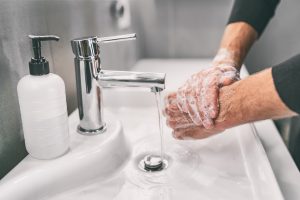
Basically, the rule suggests washing your hands for 20 seconds with soap and water to adequately remove any viruses or bacteria that may have hitched a ride. They might have jumped on when you touched the door handle or shook a colleague’s hand.
Twenty seconds has been the handwashing guideline for a long time. But researchers recently used a mathematical model to determine the key mechanics of hand washing and exactly how long it takes to remove viruses, bacteria, and other particles from the hands.
Because particles get trapped in the rough surfaces of the hand, there must be enough energy flow from water, in addition to rubbing, to properly dislodge them. How well the water works depends on the speed of your moving hands.
Therefore, if you move your hands too gently or too slowly, the force crated by the water might not be enough to remove the particles.
The researchers found that 20-seconds of vigorous hand washing – so a good, deep, authoritative scrub – could get everything off.
So, just in case you were questioning why 20-seconds is the magic number, there you go! Just slapping some soap and giving your hands the five-second once over won’t really help clean them.
Twenty seconds also helps ensure you’re getting in between all your fingers, and the other nooks, crannies, and crevices along the hands’ surface. It helps make sure you’re getting everywhere a potential infection could lurk, and that’s really the goal.
So, wash your hands for 20-seconds when you arrive home to get rid of anything you may have unknowingly picked up along the way. It can help your immune system stay strong and keep you healthy.